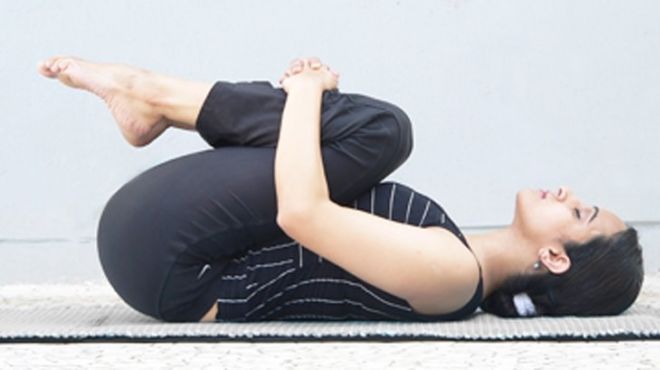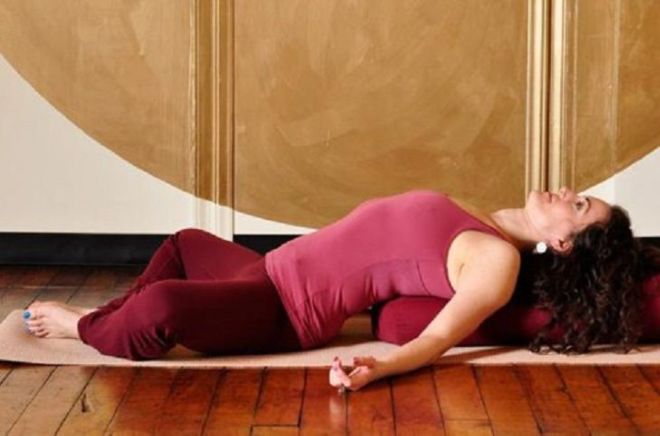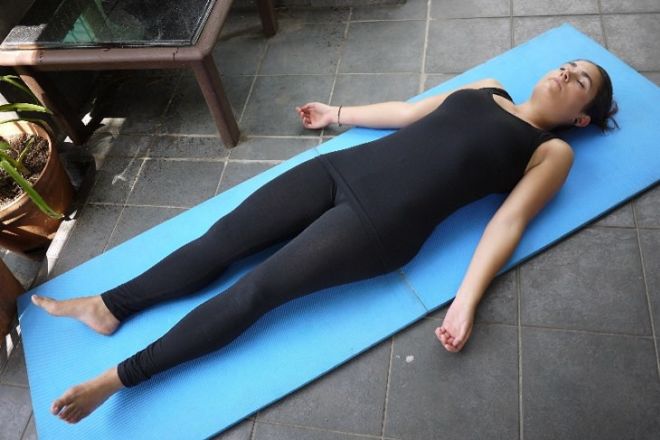Those of us who suffer from chronic back pain, which is the most common and disturbing pain, know how difficult it is sometimes to fall asleep at night. When you don’t sleep well at night, the pain only gets worse, kind of like a snowball effect. In turn, it harms the normal routine of our lives and makes it difficult for us to relax all day long. If this is the case for you, you’ll be happy to hear that through the following 4 positions in this article, which you can easily implement on a bed or yoga mat, you can release and relieve that annoying back pain.
1. Wind-Relieving Pose
The Wind-Relieving Pose, or as it is called in yoga: “Pavanamuktasana,” is designed to release your spine, especially its lower part, within moments. In addition, this position allows the bowels to be accelerated and regulated, so we’d recommend trying it in the morning.

How to do it:
- Lie on your back, relax your muscles and bend your knees up.
- Take a deep breath of air, then hug your knees with both arms.
- Release the breath, continue to hug your knees keeping them close to your chest.
- Repeat the exercise several times: on each inhale move your legs away from your chest, and each time you exhale, bring them back. Be sure to take long breaths.
- Perform about 8 to 10 reps – about 1 minute of exercise.
2. Legs Up the Wall Pose
The next position is to release tension from the back and legs, relax the chest, and allow the lungs to fill with air and oxygen before going to bed.

How to do it:
- Place a folded pillow near the wall or on the edge of the bed.
- Lie on your back with your buttocks against the pillow. Press your buttocks toward the wall and then straighten your legs up and place them against the wall.
- Spread your arms to the sides, and try to stretch and widen your chest. Relax the rest of your body, and breathe calmly.
- Stay in this position for 1-2 minutes, then lower your legs off the wall.
3. Reclining butterfly pose
The Reclining butterfly pose will have a positive effect on your back and will allow you to release its most internal muscles, those located beneath the upper layers of the skin. There are two steps that are important to perform during this pose.

How to do it:
Step 1:
- Lie on your back with two rolled towels underneath you, one under your waist and one under your neck.
- Bend your legs to each side (like a butterfly’s wings flapping) and remain as loose as possible. At the same time, move your head from side to side, without straining your neck and back. The head and leg movement can be done on the same side or opposite sides, whichever is easier for you.
- Try releasing and loosening your body as much as possible. Feel the waves of your movement penetrate your spine. Perform this step for one minute.
Step 2:
- Turn around and lie on your stomach with your arms spread out, feet resting on the bed or mattress, and a pillow or rolled towel under your forehead.
- Move your legs from side to side, and try to feel the vibrations pass through your entire relaxed body. Keep moving and perform this step for another minute.
4. The Shavasana Pose
The Shavasana Pose, whose literal meaning is “the corpse pose” is used by yogis to relax their bodies at the end of a strained workout. Doing it before bedtime will help you relax and fall asleep quickly and easily, in addition to relieving back pain.

How to do it:
- Lie on your back, gently spread your arms to your sides with your palms facing up. Place a rolled towel or a pillow under your head and neck.
- Slowly start relaxing your body from the bottom up: start with your toes and go up to your legs, hips, stomach, fingers, arms, and so on until you reach the top of your head. Relax each part on an inhalation and exhalation.
- Do 20 cycles of breathing: breathe in and breathe out slowly.
- After 20 cycles, stop counting and breathe freely. Let your thoughts float and avoid concentrating on a specific thought.
- You’ll slowly feel your surroundings becoming blurred, and your whole body will be relaxed and loose. This is the best time to cover up and fall into a nice deep sleep.




From a Super Senior Person-India: There is saying: Old is always gold. For present though it may not be palatable, in course of time, certainly You get used to it. Yoga Asanas were very Indian under Indian culture. Then people laughed at it and even made fun of the person calling him a country. Half a century has passed. Old wine in new bottle. The thinking or guidance of India is not acceptable. When it comes from West, Ohh.. what a wounderful item..let us perform and put into practice. Looking at this, I have to just laugh. Any how I am very happy to see during my lifetime itself, our olden habits have still value and cure people.
Thank God